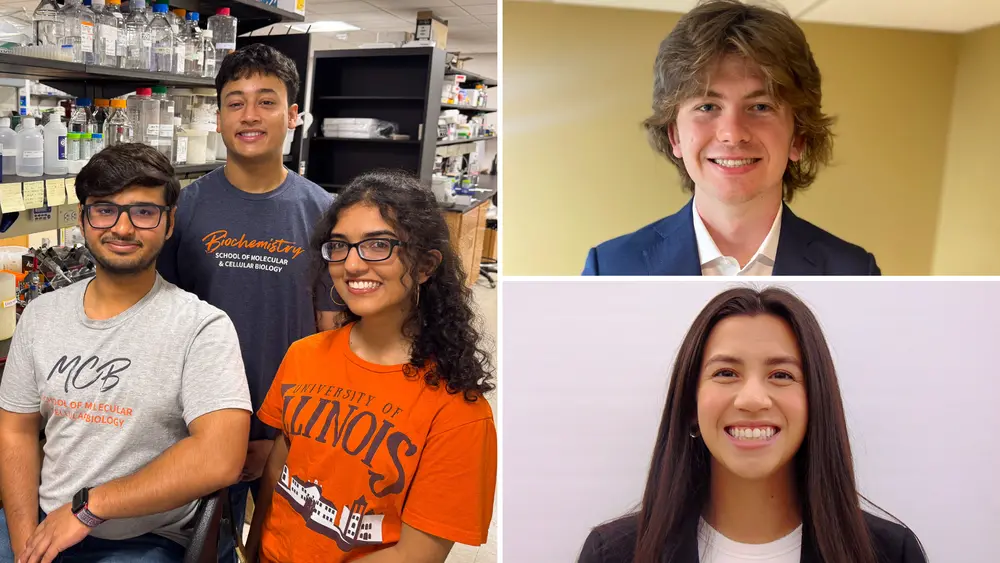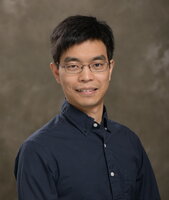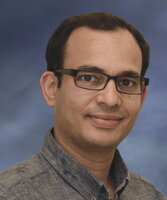
The School of Molecular & Cellular Biology is pleased to announce that several students won awards at the 2025 University of Illinois Undergraduate Research Symposium earlier this year. Congratulations to Arnab Roy and Anuprova Bhowmik from Auinash Kalsotra’s lab, Brian Rettig from Jonathan Sweedler’s lab, and Lucia Rodriguez from Nicholas Wu’s lab!
Poster Presentation
Arnab Roy, Biochemistry; Kalsotra Lab
Research Mentors: Diptatanu Das & Auinash Kalsotra, Biochemistry
"Novel Murine Diet Model That Recapitulates the Key Features of Human MetALD" (Outstanding)Anuprova Bhowmik, CS + Chemistry, Kalsotra Lab
Research Mentors: Diptatanu Das & Auinash Kalsotra, Biochemistry
"Tracking Altered Nucleo-Cytoplasmic Localization of Proteins in Hepatocytes During Development and Disease" (Honorable Mention)Brian Rettig, Molecular and Cellular Biology; Sweedler Lab
Research Mentors: Timothy Trinklein, Chemistry & Jonathan Sweedler, Chemistry
"Optimizing MALDI Matrix Application for Improved Alzheimer’s Disease Analysis" (Honorable Mention)Oral Presentation
Lucia Rodriguez, senior, Chemistry; member, Wu Lab
Research Mentors: Nicholas Wu, Biochemistry & Ruipeng Lei, Biochemistry
"Epistasis Constrains Evolution in Human H1N1 Influenza A Virus Neuraminidase" (Outstanding)
Thanks to his research experience in the lab of Auinash Kalsotra, professor of biochemistry, and the opportunity to present at the symposium, Arnab Roy said he now approaches biology and medicine by asking “why” at every step.
“This mindset has helped me develop a more curiosity-driven understanding of medicine—one that values mechanisms, reasoning, and discovery over rote learning. It’s reshaped my education in MCB at Illinois and has inspired me to pursue opportunities where I can keep asking deeper questions, whether in future clinical work and/or research,” Roy said.
His research focuses on establishing and characterizing an effective mouse model that can be used to study the rewired post-transcriptional networks found in alcohol-associated and fatty liver diseases.
Brian Rettig, who graduated in May with a bachelor’s degree in Molecular and Cellular Biology, worked with mass spectrometry to identify lipids and peptides involved in the progression of Alzheimer’s disease.
“We imaged brain and spinal cord sections from both mice and human samples with and without Alzheimer's. My specific role centered on optimizing sample preparation protocols for mass spectrometry to improve data quality and consistency,” Rettig said.
The lab experience was one of the most influential parts of his time at Illinois, Rettig said, and he was grateful to everyone in the lab of chemistry professor Jonathan Sweedler for their guidance.
“I found it both exciting and rewarding to work with such complex instruments and to witness my growth as I became more confident using them. Delving into the biological mechanisms of a disease I had personal ties to was especially meaningful and fulfilling,” he said.
Rettig is currently pursuing a master’s degree in medical sciences at Saint Louis University and plans to attend medical school.
“Although lots of my coursework was in [School of Chemical Sciences], I like to think of Burrill as my undergraduate home,” said Lucia Rodriguez, who graduated in May with a bachelor’s degree in chemistry.
She joined the lab of Nicholas Wu, assistant professor of biochemistry, a couple years ago because she wanted to gain experience with biochemistry lab techniques. She was also interested in the lab's work in influenza, in particularly studying the virus through the lenses of biochemistry and molecular evolution. Her project focused on the patterns of evolution in one of influenza's surface proteins.
“Proteins are incredibly complex macromolecules whose three-dimensional structures are dictated by their genetic code, so they are very sensitive to changes in that code. I looked at a phenomenon called epistasis, which basically means that when multiple changes occur in the genetic code, the effect on the protein might be different than we anticipate. Sometimes those changes in the code will fold up and interact to cause crazy changes in the three-dimensional structure that are unexpected. Something I really appreciate about nature is the complexity that underlies processes, like protein evolution, that are seemingly so simple.
“The big overarching question we attempt to answer in my project is how do both biology (natural selection/viral fitness) and physics (amino acid interactions/protein structures) constrain each other and the path of influenza evolution. The better we understand influenza evolution, the better we can protect ourselves from future influenza threats,” Rodriguez said.
Since graduating from Illinois, Rodriguez has joined the University of Chicago where she is studying the structure of RNA processing complexes under Dr. Cassandra Hayne. She plans to pursue a PhD in biochemistry.
As for Anuprova Bhowmik, her focus in the Kalsotra lab is on developing automated pipelines to track the distribution of key RNA-binding proteins in liver development and disease across the tissue at a sub-cellular resolution.
A Computer Science + Chemistry major, she joined the lab because of her desire to build hands-on experience with wet lab experiments and computational analysis.
“I am grateful for the incredible mentorship at this lab, and I think I've grown a lot as a student. I've learned to think critically about science and have a deeper appreciation for the interdisciplinary aspects of medicine,” she said.
Roy and Bhowmik are interested in attending medical school after they graduate.

